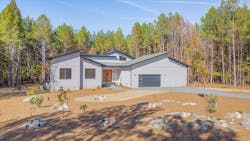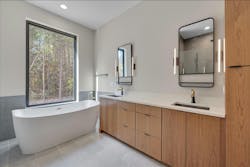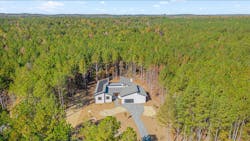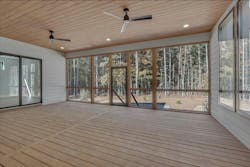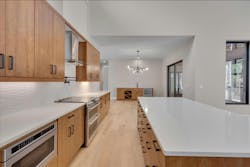Reducing Environmental Impact 12 Homes at a Time
Key Takeaways
- Jodi Bakst combined her expertise in environmental management and real estate to develop Array, North Carolina’s first 100% net-zero energy neighborhood
- The development features 12 net-zero homes, walking trails, a community garden, and more
- Builders can take steps to creating more energy-efficient homes by implementing passive heating and cooling, high-quality insulation, energy-efficient windows and appliances, and blower door testing for air leaks
This article first appeared in the July/August issue of Pro Builder.
When Jodi Bakst started her career as a real estate agent, she didn’t know she would one day develop an entire community ... but that’s exactly the case now. Bakst started her career in environmental management, eventually pivoting to real estate and becoming the owner of an agency that has served North Carolina’s greater Research Triangle area for more than 28 years.
Combining her housing industry knowledge with her environmental background, Bakst co-founded Circular Design Construction in 2018 and is currently developing Array, the state’s first-ever 100% net-zero energy neighborhood. Featuring walking trails, a community garden, and a comprehensive approach to energy-efficiency, including rooftop solar panels, the 54-acre community will showcase 12 net-zero homes when complete.
PRO BUILDER: What led you to develop Array?
Jodi Bakst: Prior to becoming a real estate agent in 1998, I worked in environmental and economic development. I have a bachelor's degree in economics and a master's in environmental management. I worked in Washington, D.C. for the Environmental Protection Agency (EPA) and an environmental law firm representing clients on environmental matters. In North Carolina I worked with Nortel and the State of North Carolina’s Department of Environmental Quality.
Initially, I wanted the neighborhood to be off the grid but I came to learn that in North Carolina, a single house can be, but neighborhoods cannot. So, the next best thing was having (all the homes in) the neighborhood be net-zero.
PB: How far along is the development?
JB: The infrastructure is complete and all of the lots are sold. Three of the twelve houses are complete and occupied. Five more houses will be done by early next year, and a sixth one later in 2026. The rest of the lots will have homes in the next few years.
PB: What does it mean to be truly net-zero, and what steps can builders take to achieve this goal?
JB: All of the houses in Array will be built to or exceed the standards set out in the covenants for the neighborhood. The houses will, at a minimum, produce as much energy as they need to operate. This is what it means to be net-zero. I am incredibly proud of the results of the first three homes.
It is not difficult to be, at a minimum, net-zero ready. In Array, the additional costs to meet the standards without an on-site renewable energy source that get you to a home energy rating score (HERS) in the 50s (on a 0-100 scale] is just 2% of the overall building cost. Developers and builders can and should be building net-zero ready houses with a HERS score at least in the 50s.
To get to net-zero, add solar to produce all the energy the home needs to operate. The more energy-efficient the house, the smaller the solar array needs to be.
PB: For those who can’t achieve net-zero, what are some simple steps housing pros can take to reduce their impact?
JB: The simplest thing to do if you are building a home is orient it for passive heating and cooling. Then, use at least R-19 insulation in the walls and insulate so there are no air leakages, install energy-efficient doors and windows, Energy Star-certified appliances and, at a minimum, an 18-SEER, high-efficiency heat pump.
Things vary by climate zone, so it is important to pay attention to what’s best for your location. For example, in North Carolina, because the climate is moderate, triple-pane (window) glass is not necessary, but in colder climates it is something worth considering.
If you are retrofitting a home, the very best thing is to conduct a blower door test to find all of the air leakages in the house and tighten them up. Add insulation in the attic. Seal the crawl space and provoide conditioned air. And when it’s time to replace appliances, purchase Energy Star-certified products, high-efficiency heat pumps, and a high-efficiency heat pump water heater.
PB: What’s the current demand for energy efficient housing?
JB: There is a significant demand for energy efficient houses including net-zero ready and net-zero. The more that are built, the more people will come. Over the years, I have had hundreds of people come to Array, but no development or location is right for everyone. Many people ask me if I’m doing another development like Array in another part of town.
For some reason, builders resist building this way. The more energy-efficient houses in our market have HERS in the 60s. That’s much better than a code-built home at HERS 100, but they can do better.
PB: What’s been the biggest hurdle to getting this project off the ground?
JB: The biggest hurdle was the funding. I am a Realtor, not a developer. I thought the original land owner would be the developer and I would be the project manager. Once my client purchased the land, he told me he didn’t want to be the developer, but would let me develop it and pay him back later. I searched high and low for partners to develop the land with, but I turned up absolutely no one.
So, I had to make the decision to go this alone and decide how I was going to structure it. Once I wrote the first payment to the civil engineer, I had made the step to be a developer. After five years of hard work and absolute grit, I pulled it off with zero debt.
RELATED:
- Taking a Thoughtful Approach to Home Building
- The Eco-Friendly Products Buyers Want in Their Homes
- A Home for the Ages: Sustainability, Health, and Attainability in One
PB: Do you have future plans for similar developments?
JB: I do not. If someone comes to me and wants to partner or ask me to manage the project, I will absolutely consider it. My heart is in this. I feel very fortunate I was able to create Array and have it be such an incredible success.
PB: What would you like people to take away from this project?
JB: I want people to know that they can live sustainably and that the choices we make should take our carbon footprint into consideration. The real estate sector can and should contribute to reducing our carbon footprint.
About the Author

Catherine Sweeney, Associate Editor
Catherine Sweeney is the associate editor for Pro Builder and Custom Builder Online.
